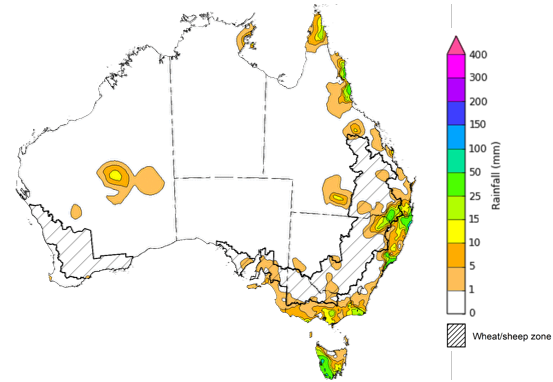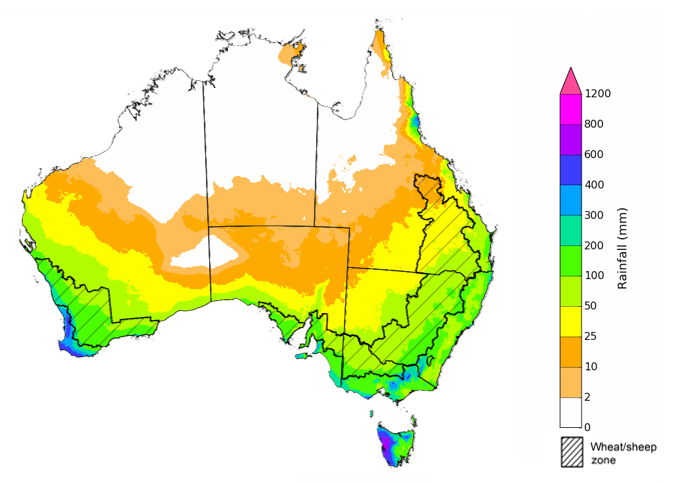Key issues
- In the week ending 22 May 2024, a high-pressure system kept much of Australia dry. Exceptions were: central parts of Western Australia, which recorded up to 15 millimetres of rainfall associated with a low pressure trough; along the eastern coastline that recorded up to 50 millimetres of rainfall in some areas associated with moist onshore flow; and Tasmania recorded up to 100 millimetres of rainfall from cold fronts.
- Across cropping regions, isolated falls of up to 25 millimetres were recorded in north-eastern New South Wales and up to 50 millimetres in far south-eastern Queensland. Mostly dry conditions elsewhere would have allowed planting operations of winter crops and harvest of summer crops to continue without delay.
- Lack of rainfall in Victoria, South Australia and Western Australia would delay the germination of winter crops and result in further declines in soil moisture.
- Over coming days, high-pressure systems are expected to keep Australia largely dry. The main exceptions being western Tasmania and the far southwest Western Australia where cold fronts are expected to bring up to 50 millimetres of rainfall. A low-pressure system is also expected to bring rainfall totals of up to 100 millimetres to isolated areas of north-eastern Queensland.
- Across cropping regions, conditions are forecast to be largely dry, with a maximum of 5 millimetres of rainfall forecast for scattered areas in Queensland and New South Wales, and much of western Victoria, South Australia and Western Australia.
- Risks to production from declining soil moisture continue, particularly in Western Australia, South Australia and western Victoria where rainfall has been deficient for much of April and May-to-date.
- The national rainfall outlook for June to August is for above median rainfall for much of the southern half of Australia, with exceptions in Victoria and Tasmania.
- Across cropping regions, the probability of exceeding median rainfall is between 40% and 60% in the eastern states and South Australia, while Western Australia cropping regions have a higher probability (50 to 75%) of receiving above median rainfall.
- Water storage levels in the Murray-Darling Basin (MDB) increased between 16 May 2024 and 23 May 2024 by 85 gigalitres (GL). Current volume of water held in storage is 16 726 GL, equivalent to 75% of total storage capacity. This is 15 percent or 3,378 GL less than at the same time last year. Water storage data is sourced from the BOM.
- Allocation prices in the Victorian Murray below the Barmah Choke decreased from $22 on 16 May 2024 to $20 on 23 May 2024. Prices are lower in the Murrumbidgee due to the binding of the Murrumbidgee export limit.
Climate
For the week ending 22 May 2024, a high-pressure system brought dry conditions to much of Australia. Exceptions were: central parts of Western Australia, which recorded up to 15 millimetres of rainfall associated with a low pressure trough; along the eastern coastline recorded up to 50 millimetres of rainfall in some areas associated with moist onshore flow; and Tasmania recorded up to 100 millimetres of rainfall from cold fronts.
Across cropping regions, isolated falls of up to 25 millimetres were recorded in north-eastern New South Wales and up to 50 millimetres in far south-eastern Queensland. Most cropping regions recorded little to no rainfall for the week ending 22 May 2024. Mostly dry conditions in New South Wales and Queensland would have allowed planting operations of winter crops and harvest of summer crops to continue without delay. Across Victoria, South Australia and Western Australia the lack of rainfall would have continued to delay the germination of winter crops and resulted in further declines in soil moisture.
Rainfall for the week ending 22 May 2024

Issued: 22/05/2024
Note: The rainfall analyses and associated maps utilise data contained in the Bureau of Meteorology climate database, the Australian Data Archive for Meteorology (ADAM). The analyses are initially produced automatically from real-time data with limited quality control. They are intended to provide a general overview of rainfall across Australia as quickly as possible after the observations are received. For further information go to http://www.bom.gov.au/climate/rainfall/
Over the 8 days to 30 May 2024, high-pressure systems are expected to keep Australia largely dry. The main exceptions being western Tasmania and the far southwest of Western Australia where cold fronts are expected to bring up to 50 millimetres of rainfall. A low-pressure system is expected to bring rainfall to totals of up to 100 millimetres to isolated areas of north-eastern Queensland.
Across cropping regions, conditions are expected to remain dry. A maximum of 5 millimetres of rainfall is forecast for scattered areas in Queensland and New South Wales, and much of western Victoria, South Australia and Western Australia. Risks to production remain from declining soil moisture where rainfall has been deficient for much of April and May to date.
Total forecast rainfall for the period 23 May to 30 May 2024

Issued 23/05/2024
Note: This rainfall forecast is produced from computer models. As the model outputs are not altered by weather forecasters, it is important to check local forecasts and warnings issued by the Bureau of Meteorology.
The most recent rainfall outlook for June 2024 provided by the Bureau of Meteorology indicates an increased likelihood of above median rainfall across much of Western Australia and South Australia, as well as parts of southern Queensland and western New South Wales. Below median rainfall is more likely across parts of tropical northern Australia, southern New South Wales extending into northeastern Victoria, and along scattered area of Australia’s southern coastline and Tasmania. There is an equal chance of either above or below median rainfall likely elsewhere.
According to Bureau of Meteorology’s climate model, for June 2024 there is a 75% probability of rainfall totals between 25 to 50 millimetres across parts of New South Wales and coastal Queensland and much of Victoria, and southern South Australia. High elevation and coastal areas can receive up to 100 millimetres of rainfall in these states. Far southwest Western Australia and western Tasmania are anticipated to receive up to 200 millimetres of rainfall. The northern Australia is expected to remain largely dry.
Across cropping regions, there is a 75% chance of rainfall totals between 10 to 50 millimetres in New South Wales, Victoria, South Australia and up to 100 millimetres in Western Australia. In Queensland, a maximum of 25 millimetres is expected in the south. If realised, these expected rainfall totals should be sufficient to allow for the germination and establishment of winter crops.
Rainfall totals that have a 75% chance of occurring in June 2024

Issued: 23/05/2024
The El Niño Southern Oscillation (ENSO) and Indian Ocean Dipole (IOD) climate drivers are currently neutral and having minimal influence on Australian rainfall.
The rainfall outlook for June through August indicates that above median rainfall is more likely across much of the southern half of Australia, with exceptions in southern parts of Victoria and South Australia, as well as in Tasmania, where below median rainfall is more likely. In the Northern Tropics, which has entered its dry season, rainfall totals over the period are expected to be below the median, except for in parts of northeast Queensland where above median rainfall is highly likely. Remaining areas have an equal chance of having above or below median rainfall.
Across cropping regions, the probability of exceeding median rainfall is between 40% and 60% in the eastern states and South Australia, while Western Australia cropping regions have a higher probability (between 50 and 75%) of receiving above median rainfall.
Chance of exceeding the median rainfall June to August 2024

Issued: 23/05/2024
Note: The world precipitation percentiles indicate a ranking of precipitation for March, with the driest (0th percentile) being 0 on the scale and the wettest (100th percentile) being 1 on the scale. Percentiles are based on precipitation estimates from the NOAA Climate Prediction Center’s Climate Anomaly Monitoring System Outgoing Precipitation Index dataset. Precipitation estimates for April 2024 are compared with rainfall recorded for that period during the 1981 to 2010 base period. Source: International Research Institute for Climate and Society
The outlook for June to August 2024 suggests there is at least a 75% chance of rainfall totals of up to 200 millimetres across much of southern Australia, with up to 400 millimetres likely in scattered parts of New South Wales, Victoria and South Australia. In western Tasmania, rainfall is expected to reach up to 800 millimetres over the period. Far southwest Western Australia is likely to receive up to 600 millimetres of rainfall. In contrast, northern Australia is likely to remain largely dry.
In cropping regions, there is at least a 75% chance of receiving between 100 and 200 millimetres across much of South Australia, Western Australia and parts of southern Victoria and eastern New South Wales. Remaining areas across eastern South Australia, Victoria and New South Wales, as well as southern Queensland are expected to receive between 50 and 100 millimetres. Central and northern cropping regions in Queensland are expected to receive rainfall totals of between 10 and 50 millimetres.
Considering the recent declines in upper layer soil moisture levels, particularly in South Australia, Western Australia and western parts of Victoria, sufficient and timely rainfall will be required in the coming months to facilitate the germination and establishment of winter crops. This generally favourable rainfall outlook of June to August is expected to support the germination of dry sown crops and follow up winter crop planting towards the end of the ideal planting window.
Livestock producers, especially those in the south, are expected to experience close to average pasture production on the back of the improving rainfall outlook over the June to August period.
Rainfall totals that have a 75% chance of occurring June to August 2024

Issued: 23/05/2024
Water
Water storages, water markets and water allocations - current week
The Tableau dashboard may not meet accessibility requirements. For information about the contents of these dashboards contact ABARES.
Commodities
Information on weekly price changes in agricultural commodities is now available at the Weekly commodity price update.
